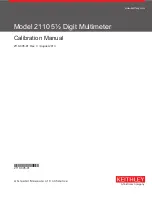
Chapter 1. System Overview and Modes of Operation
1
Chapter 1. SYSTEM OVERVIEW AND MODES OF OPERATION
This manual details the Coastcom D/I Mux III multiplexer for use with T1 connections. Users unfamiliar
with T1 technology are encouraged to refer to commercially published material on T1 for more
information, however the basic concepts of T1 are relatively simple. Essentially, a T1 line is a 4 wire,
high speed phone line capable of carrying many individual phone connections, analogous to a large
conduit.
The T1 network facilitates high speed transmission of large volumes of digitized voice and data signals
over extended distances. T1 standards provide transmission of up to twenty-four 64 Kbps channels
(DS0s) sequentially.
A multiplexer is a device that takes voice and data inputs from various types of telecommunication
devices and converts them into a data stream which is sent over the T1 line. This technology is called
multiplexing, and it allows telecomm users to send and receive a large volume of traffic over wide areas
efficiently, while still enjoying direct connections to individual phones, modems, and other similar
equipment. The T1 line constitutes what is referred to as a DS1 channel. The individual channels that
make up the DS1 are referred to as DS0s.
D/I Mux III Capabilities
Coastcom's D/I Mux III family of intelligent T1 multiplexers offers fully programmable, easy to use
software-controlled voice and data multiplexing.
One or two T1 digital transmission systems are easily accessed with a D/I Mux III. Voice, data, and
special service circuits are all available within one compact system. The D/I Mux III supplies 48 DS0
transmission channels, and with 5-port Subrate Data Multiplexer (SDM) channel cards, up to 120 data
circuits can be accessed in a single system.
All of the D/I Mux III card slots can be mapped to any T1 span. Drop-and-insert users can also reuse
DS0s that are dropped from one T1 span (for example, the T1-1 span) by inserting them in the opposite
T1 span (T1-2).
D/I Mux III multiplexers can be placed in several modes of operation without changing hardware. The D/I
Mux III can be configured for channel bank, drop-and-insert, dual channel bank, or optionally, Automatic
Loop Protection Switching (ALPS
™
) operation. ALPS is designed to maintain communications after a T1
line break, or system failure; and with system redundancy, ALPS operation requires special common
equipment hardware. With ALPS hardware all modes of operation are accessible. For more details on
ALPS see the
ALPS User's Manual
.
The D/I Mux III meets AT&T's T1 compatibility specifications for electrical performance, and for alarm
and restoration sequences (AT&T Publications 43801 and 62411).
Summary of Contents for D/I Mux III System
Page 20: ......
Page 36: ...Chapter 1 System Overview and Modes of Operation 16 ...
Page 51: ...Chapter 1 System Overview and Modes of Operation 31 ...
Page 79: ...Chapter 3 Installation 59 ...
Page 232: ...D I Mux III User s Manual Appendix B 24 Volt Systems 212 APPENDIX B 24 VOLT SYSTEMS ...
Page 237: ...D I Mux III User s Manual Appendix D Preconfigured Maps APPENDIX D PRECONFIGURED MAPS ...
Page 243: ...D I Mux III User s Manual Appendix E SNMP APPENDIX E SNMP ...
Page 265: ...D I Mux III User s Manual Appendix G Modem Interfaces APPENDIX G MODEM INTERFACES ...
Page 284: ...D I Mux III User s Manual Appendix H Set Report Options APPENDIX H SET REPORT OPTIONS ...
















































